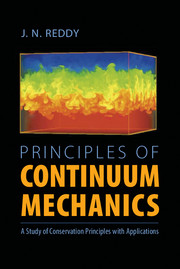Book contents
- Frontmatter
- Contents
- Preface
- 1 Introduction
- 2 Vectors and Tensors
- 3 Kinematics of a Continuum
- 4 Stress Vector and Stress Tensor
- 5 Conservation of Mass, Momentum, and Energy
- 6 Constitutive Equations
- 7 Applications in Heat Transfer, Fluid Mechanics, and Solid Mechanics
- Answers to Selected Problems
- References and Additional Readings
- Subject Index
1 - Introduction
- Frontmatter
- Contents
- Preface
- 1 Introduction
- 2 Vectors and Tensors
- 3 Kinematics of a Continuum
- 4 Stress Vector and Stress Tensor
- 5 Conservation of Mass, Momentum, and Energy
- 6 Constitutive Equations
- 7 Applications in Heat Transfer, Fluid Mechanics, and Solid Mechanics
- Answers to Selected Problems
- References and Additional Readings
- Subject Index
Summary
One thing I have learned in a long life: that all our science, measured against reality, is primitive and childlike–and yet it is the most precious thing we have.
Albert EinsteinContinuum mechanics
Matter is composed of discrete molecules, which in turn are made up of atoms. An atom consists of electrons, positively charged protons, and neutrons. Electrons form chemical bonds. An example of mechanical (i.e., has no living cells) matter is a carbon nanotube (CNT), which consists of carbon molecules in a certain geometric pattern in equilibrium with each other, as shown in Figure 1.1.1.
Another example of matter is a biological cell, which is a fundamental unit of any living organism. There are two types of cells: prokaryotic and eukaryotic cells. Eukaryotic cells are generally found in multicellular organs and have a true nucleus, distinct from a prokaryotic cell. Structurally, cells are composed of a large number of macromolecules, or large molecules. These macromolecules consist of large numbers of atoms and form specific structures, like chromosomes and plasma membranes in a cell. Macromolecules occur as four major types: carbohydrates, proteins, lipids, and nucleic acids. To highlight the hierarchical nature of the structures formed by the macromolecule in a cell, let us analyze a chromosome.
Chromosomes, which are carriers of hereditary traits in an individual, are found inside the nucleus of all eukaryotes.
- Type
- Chapter
- Information
- Principles of Continuum MechanicsA Study of Conservation Principles with Applications, pp. 1 - 9Publisher: Cambridge University PressPrint publication year: 2010



